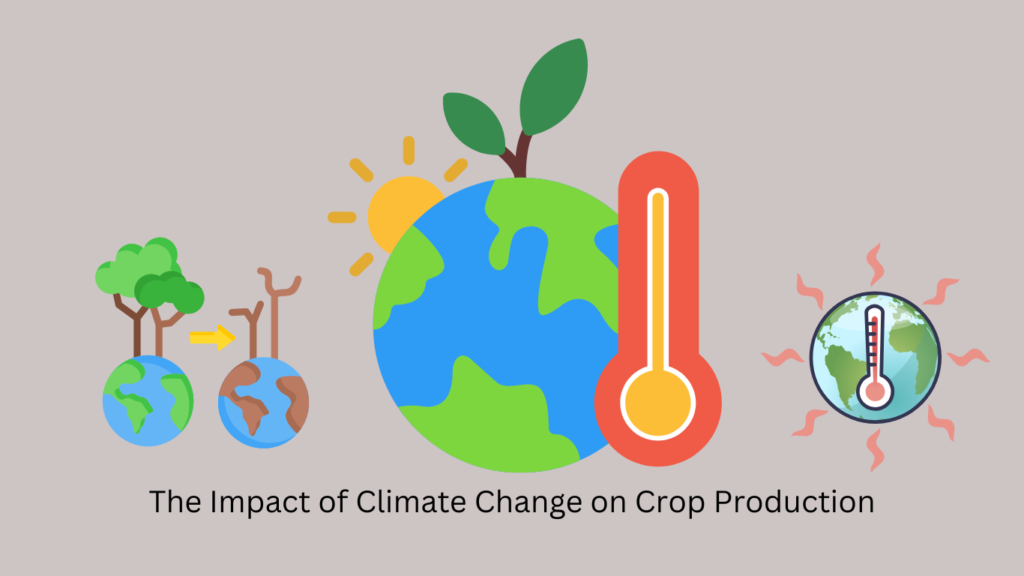The Impact of Climate Change on Crop Production
Introduction
Climate change is one of the most significant challenges facing global agriculture today. Rising temperatures, shifting precipitation patterns, extreme weather events, and increased carbon dioxide (CO2) levels are affecting crop yields, food security, and farming practices. This document explores how climate change influences crop production, the risks involved, and possible mitigation strategies.
Key Climate Change Factors Affecting Crop Production
- Rising Temperatures – Increased heat stress affects plant growth and reduces yields.
- Changing Rainfall Patterns – Unpredictable rainfall disrupts irrigation and soil moisture levels.
- Extreme Weather Events – Storms, floods, and droughts damage crops and farmlands.
- Increased CO2 Levels – Some crops benefit from higher CO2, while others suffer nutrient deficiencies.
- Soil Degradation – Climate-related erosion and loss of organic matter impact soil fertility.
- Pest and Disease Outbreaks – Warmer climates allow pests and pathogens to thrive.
- Water Scarcity – Reduced water availability limits irrigation and crop growth.
Effects of Climate Change on Different Crops
- Cereal Crops (Wheat, Rice, Maize, Barley)
- Higher temperatures shorten growing seasons, reducing yields.
- Heat stress affects pollination and grain filling.
- Extreme weather events increase crop failures.
- Legumes (Soybeans, Lentils, Chickpeas, Peas)
- Rising CO2 levels may enhance growth but reduce protein content.
- Water stress limits nodulation and nitrogen fixation.
- Increased pest pressure impacts productivity.
- Fruits and Vegetables
- Heat stress affects flowering and fruit set.
- Water shortages impact quality and yield.
- Higher temperatures increase spoilage and post-harvest losses.
- Cash Crops (Coffee, Cocoa, Cotton, Tea)
- Changing climate shifts suitable growing regions.
- Quality and flavor profiles may be altered.
- Droughts and extreme heat reduce production.
- Root and Tuber Crops (Potatoes, Cassava, Sweet Potatoes, Yams)
- Some crops (cassava) tolerate heat better than others (potatoes).
- Soil degradation affects root development.
- Pest outbreaks increase with temperature rise.
Table: Climate Change Impact on Crop Production
| Crop Type | Key Climate Risks | Possible Adaptation Strategies |
|---|---|---|
| Wheat | Heat stress, drought, pests | Heat-resistant varieties, irrigation improvements |
| Rice | Flooding, salinity, pests | Salt-tolerant strains, water management |
| Maize | Drought, extreme heat | Drought-resistant hybrids, mulching |
| Soybeans | Heat, pests, water stress | Improved pest control, precision agriculture |
| Coffee | Temperature shifts, drought | Agroforestry, shade-grown systems |
| Cotton | Drought, extreme weather | Soil moisture conservation, no-till farming |
| Potatoes | Heat stress, soil degradation | Sustainable soil management, resistant varieties |
Adaptation and Mitigation Strategies
- Developing Climate-Resilient Crop Varieties
- Breeding heat, drought, and pest-resistant crops.
- Genetic modifications to improve stress tolerance.
- Water Management Innovations
- Drip irrigation and rainwater harvesting.
- Efficient irrigation scheduling based on climate patterns.
- Sustainable Soil Management
- Cover cropping and organic amendments.
- Conservation tillage to improve soil structure.
- Agroforestry and Biodiversity Conservation
- Integrating trees into farming systems to buffer climate extremes.
- Encouraging crop diversification to reduce risk.
- Improved Pest and Disease Control
- Implementing Integrated Pest Management (IPM).
- Using biological control methods and resistant crop varieties.
- Climate-Smart Agricultural Practices
- Adjusting planting schedules based on climate predictions.
- Utilizing data-driven precision farming techniques.
Challenges in Addressing Climate Change Impact on Agriculture
- High Costs of Adaptation – Investment in technology and infrastructure.
- Knowledge Gaps – Need for farmer education and research dissemination.
- Policy and Governance Issues – Lack of coordinated responses to climate risks.
- Uncertainty in Climate Predictions – Difficulty in long-term planning for farmers.
Conclusion
Climate change presents a significant threat to global crop production, but adaptation strategies can help mitigate its effects. By implementing climate-smart agricultural practices, developing resilient crop varieties, and improving water and soil management, farmers can enhance food security while reducing environmental impact. Investing in research and policy support is essential for long-term agricultural sustainability in the face of climate change.



